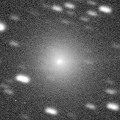
|
Bright new comet. It will approach to Sun down to 0.22 a.u. in mid September, and it is expected to brighten up to 2 mag. Now it is 7.6 mag (Aug. 26, Virgilio Gonano). It will turn to fade out rapidly after brightening. In the Northern Hemisphere, it will be unobservable in September. In the Southern Hemisphere, it is not observable now, but it will appear in October.
Date(TT) R.A. (2000) Decl. Delta r Elong. m1 Best Time(A, h)
Aug. 26 7 59.47 22 13.9 1.289 0.737 34 8.2 3:58 (253, 15)
Sept. 2 8 48.54 23 57.2 1.068 0.565 31 6.7 4:05 (250, 13)
|

|
It is expected to brighten up to 7.5 mag in October. Now it is 11.8 mag (Aug. 23, Ken-ichi Kadota). Brightening gradually. In the Northern Hemisphere, it stays observable in good condition. It locates somewhat low in the Southern Hemisphere. But it will become high in autumn.
Date(TT) R.A. (2000) Decl. Delta r Elong. m1 Best Time(A, h)
Aug. 26 2 2.59 40 51.1 0.491 1.245 106 10.0 3:47 (180, 84)
Sept. 2 2 50.76 42 41.6 0.448 1.200 104 9.5 4:05 (184, 82)
|

|
Now it is 9.9 mag (Aug. 25, Chris Wyatt). Fading gradually. In the Northern Hemisphere, it will be getting lower gradually. In the Southern Hemisphere, it stays observable in good condition.
Date(TT) R.A. (2000) Decl. Delta r Elong. m1 Best Time(A, h)
Aug. 26 2 52.14 -7 44.8 1.994 2.553 112 9.6 3:58 (345, 46)
Sept. 2 2 42.19 -12 18.4 1.924 2.592 120 9.6 4:00 ( 0, 43)
|

|
It brightened up to 7.8 mag in late July (July 20, Thomas Lehmann). Now it is 11.4 mag (Aug. 24, Ken-ichi Kadota). Fading rapidly. It will be unobservable in October. But it will be observable again in November in the Northern Hemisphere.
Date(TT) R.A. (2000) Decl. Delta r Elong. m1 Best Time(A, h)
Aug. 26 14 58.08 -20 55.9 1.415 1.526 75 10.1 20:04 ( 49, 16)
Sept. 2 14 53.87 -18 32.4 1.626 1.552 67 10.5 19:53 ( 54, 15)
|
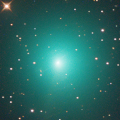
|
It brightened up to 8.4 mag in late July (July 22, Thomas Lehmann). Now it is 9.7 mag (Aug. 25, Chris Wyatt). Fading rapidly. It will be fainter than 18 mag in November. It stays observable in good condition.
Date(TT) R.A. (2000) Decl. Delta r Elong. m1 Best Time(A, h)
Aug. 26 21 54.57 19 48.9 0.393 1.363 149 10.8 23:38 ( 0, 74)
Sept. 2 22 1.65 6 43.8 0.441 1.435 161 11.5 23:17 ( 0, 61)
|
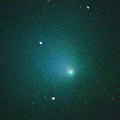
|
It will brighten up to 7.5 mag in October. Now it is 11.7 mag (Aug. 15, Michael Jager). It will turn to fade out rapidly after brightening. It will be unobservable in September in the Southern Hemisphere, or in October in the Northern Hemisphere.
Date(TT) R.A. (2000) Decl. Delta r Elong. m1 Best Time(A, h)
Aug. 26 5 36.41 33 38.6 1.198 1.238 67 12.5 3:58 (257, 48)
Sept. 2 6 20.10 34 6.5 1.086 1.131 65 11.3 4:05 (255, 47)
|
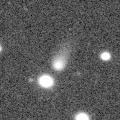
|
It is expected to brighten up to 7 mag in early 2024. Now it is 12.7 mag (Aug. 21, Chris Wyatt). It will brighten rapidly after this. In the Northern Hemisphere, it is not observable now, but it will appear in November. It locates somewhat low in the Southern Hemisphere. But it will become high in winter. The brightness evolution slowed down since May.
Date(TT) R.A. (2000) Decl. Delta r Elong. m1 Best Time(A, h)
Aug. 26 8 41.45 -27 13.9 3.337 2.709 44 11.9 3:58 (289,-21)
Sept. 2 8 56.09 -28 6.7 3.259 2.635 44 11.8 4:05 (293,-17)
|

|
It brightened up to 8 mag from 2022 summer to 2023 spring. Now it is 11.8 mag (Aug. 24, Ken-ichi Kadota). It stays 12 mag for a while. In the Northern Hemisphere, it will be getting higher gradually. In the Southern Hemisphere, it stays observable in good condition.
Date(TT) R.A. (2000) Decl. Delta r Elong. m1 Best Time(A, h)
Aug. 26 6 42.93 -8 18.9 3.915 3.461 56 11.8 3:58 (290, 13)
Sept. 2 6 45.87 -8 14.5 3.899 3.525 61 11.9 4:05 (295, 19)
|
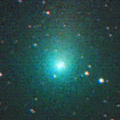
|
It brightened up to 9.5 mag from winter to early spring (Jan. 30, Katsumi Yoshimoto). Now it is 12.2 mag (Aug. 25, Osamu Miyazaki). It will fade out rapidly after this. It stays observable in good condition.
Date(TT) R.A. (2000) Decl. Delta r Elong. m1 Best Time(A, h)
Aug. 26 23 58.87 19 2.6 2.047 2.903 141 12.4 1:45 ( 0, 74)
Sept. 2 23 46.66 15 52.7 2.043 2.967 151 12.5 1:06 ( 0, 71)
|
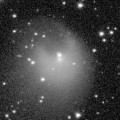
|
It returns for the first time in 70 years. It will brighten up to 4.5 mag in 2024 spring. It suddenly brightened in outburst by 5 mag up to 11.5 mag on July 20 (E. Tamas, Francois Kugel). Now it is 11.8 mag (Aug. 18, Ken-ichi Kadota). Brightening slowly. In the Northern Hemisphere, it stays observable in good condition. In the Southern Hemisphere, it will be unobservable in October.
Date(TT) R.A. (2000) Decl. Delta r Elong. m1 Best Time(A, h)
Aug. 26 17 29.54 53 3.9 3.317 3.502 92 12.6 20:04 (157, 70)
Sept. 2 17 24.39 51 59.2 3.276 3.427 89 12.8 19:53 (147, 68)
|

|
Now it is 13.7 mag (July 14, Chris Wyatt). It stays 13 mag for a while. Now it is not observable. It will appear in September in the Southern Hemisphere, or in October in the Northern Hemisphere.
Date(TT) R.A. (2000) Decl. Delta r Elong. m1 Best Time(A, h)
Aug. 26 10 32.15 -14 43.0 4.750 3.864 25 12.9 20:04 ( 93,-31)
Sept. 2 10 34.39 -15 50.6 4.785 3.886 24 13.0 4:05 (268,-31)
|

|
Now it is 13.6 mag (Aug. 25, Chris Wyatt). Fading slowly. In the Northern Hemisphere, it is not observable now. It locates somewhat low in the Southern Hemisphere. But it will become high in autumn. It was expected to brighten up to 10 mag from spring to summer. However, it is fainter than originally expected.
Date(TT) R.A. (2000) Decl. Delta r Elong. m1 Best Time(A, h)
Aug. 26 11 21.51 -75 50.0 3.143 3.252 87 13.3 20:04 ( 17,-37)
Sept. 2 11 26.99 -75 17.2 3.227 3.275 83 13.4 19:53 ( 18,-38)
|

|
It brightened up to 8.3 mag in 2021-2022 winter (Jan. 6, 2022, Toshiyuki Takahashi). Now it is 13.2 mag (July 14, Chris Wyatt). It stays 14 mag for a while. In the Northern Hemisphere, it is not observable now, but it will appear in November. It locates somewhat low in the Southern Hemisphere. But it will become high in autumn.
Date(TT) R.A. (2000) Decl. Delta r Elong. m1 Best Time(A, h)
Aug. 26 10 19.37 -33 11.9 6.894 6.205 43 13.4 20:04 ( 74,-41)
Sept. 2 10 25.11 -33 50.8 6.960 6.250 42 13.5 4:05 (289,-37)
|

|
It approached to Sun down to 0.05 a.u. on Aug. 21, and it must have brightened up to 5.5 mag. It will fade out rapidly after this. It will be fainter than 18 mag in September. It will never be observable after this.
Date(TT) R.A. (2000) Decl. Delta r Elong. m1 Best Time(A, h)
Aug. 26 10 37.01 8 23.8 1.260 0.271 5 13.4 20:04 (111,-16)
Sept. 2 11 22.36 2 23.8 1.461 0.514 11 16.7 19:53 (102,-14)
|
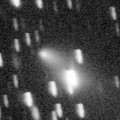
|
Now it is 13.8 mag (Aug. 17, Ken-ichi Kadota). Fading gradually. In the Northern Hemisphere, it stays observable in good condition. In the Southern Hemisphere, it will be unobservable in September.
Date(TT) R.A. (2000) Decl. Delta r Elong. m1 Best Time(A, h)
Aug. 26 2 42.74 41 34.7 1.329 1.801 99 13.6 3:58 (220, 81)
Sept. 2 2 43.53 46 23.4 1.303 1.826 103 13.7 4:02 (180, 79)
|

|
Now it is 13.3 mag (Aug. 17, Ken-ichi Kadota). It will fade out rapidly after this. It will be fainter than 18 mag in December. It stays observable in good condition.
Date(TT) R.A. (2000) Decl. Delta r Elong. m1 Best Time(A, h)
Aug. 26 19 28.24 -0 2.8 1.297 2.149 136 13.7 21:11 ( 0, 55)
Sept. 2 19 29.72 -0 31.3 1.365 2.170 131 14.0 20:45 ( 0, 54)
|
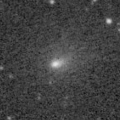
|
Now it is 13.7 mag (Aug. 14, Thomas Lehmann). It will fade out rapidly after this. It will be fainter than 18 mag in November. In the Northern Hemisphere, it will be getting lower gradually. In the Southern Hemisphere, it stays observable in good condition.
Date(TT) R.A. (2000) Decl. Delta r Elong. m1 Best Time(A, h)
Aug. 26 19 16.49 10 5.0 0.827 1.672 130 13.8 20:58 ( 0, 64)
Sept. 2 19 3.50 -1 13.2 0.936 1.726 125 14.2 20:18 ( 0, 53)
|
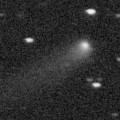
|
Now it is 14.2 mag (Aug. 17, Ken-ichi Kadota). Fading slowly. It stays observable in good condition.
Date(TT) R.A. (2000) Decl. Delta r Elong. m1 Best Time(A, h)
Aug. 26 1 50.06 7 45.3 2.677 3.347 123 13.9 3:36 ( 0, 63)
Sept. 2 1 36.17 7 40.7 2.586 3.365 133 13.8 2:55 ( 0, 63)
|

|
Now it is 13.7 mag (Aug. 11, Jean-Francois Soulier). In the Northern Hemisphere, it will be getting higher gradually. It locates somewhat low in the Southern Hemisphere.
Date(TT) R.A. (2000) Decl. Delta r Elong. m1 Best Time(A, h)
Aug. 26 8 6.67 22 58.7 6.949 6.130 33 14.1 3:58 (252, 14)
Sept. 2 8 11.64 22 41.5 6.884 6.132 38 14.1 4:05 (256, 20)
|
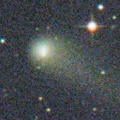
|
It brightened up to 11.1 mag in early 2022 (Mar. 31, 2022, F. Kugel, J.-G. Bosch, J. Nicolas). Now it is 13.9 mag (Aug. 5, Hirohisa Sato). It stays 15 mag for a while. In the Northern Hemisphere, it will be getting lower gradually. But it will be getting higher again after December. In the Southern Hemisphere, it will be unobservable in October.
Date(TT) R.A. (2000) Decl. Delta r Elong. m1 Best Time(A, h)
Aug. 26 15 23.42 19 7.7 5.752 5.560 74 14.1 20:04 ( 80, 48)
Sept. 2 15 26.95 18 41.4 5.866 5.595 69 14.2 19:53 ( 82, 45)
|

|
It will approach to Earth down to 0.2 a.u. in November, and it is expected to brighten up to 7.5 mag. Now it is 14.5 mag (Aug. 14, Michael Jager). Brightening rapidly. It locates somewhat low in the Northern Hemisphere. But it will become high in autumn. In the Southern Hemisphere, it is not observable now, but it will appear in November.
Date(TT) R.A. (2000) Decl. Delta r Elong. m1 Best Time(A, h)
Aug. 26 11 39.01 43 20.1 2.091 1.424 37 14.6 20:04 (132, 16)
Sept. 2 11 41.60 43 20.8 1.990 1.338 37 14.3 19:53 (133, 14)
|
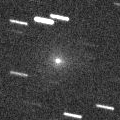
|
It was expected to brighten up to 11 mag in July. But actually, it is fainter than originally expected. Now it is 13.3 mag (July 24, Ken-ichi Kadota). Fading rapidly. It will be fainter than 18 mag in October. It locates somewhat low in the Northern Hemisphere. It stays extremely low in the Southern Hemisphere.
Date(TT) R.A. (2000) Decl. Delta r Elong. m1 Best Time(A, h)
Aug. 26 8 1.41 13 9.6 1.831 1.130 33 14.4 3:58 (261, 10)
Sept. 2 8 23.93 11 13.8 1.877 1.187 34 14.9 4:05 (264, 11)
|

|
The ATLAS search program detected its cometary activity in April. It continues to be brightening even after the perihelion passage. Now it is 13.2 mag (Aug. 21, Alan Hale). Fading gradually. It locates somewhat low in the Northern Hemisphere. But it will become high in autumn. In the Southern Hemisphere, it stays observable in good condition.
Date(TT) R.A. (2000) Decl. Delta r Elong. m1 Best Time(A, h)
Aug. 26 23 56.63 -27 8.6 2.016 2.943 151 14.5 1:43 ( 0, 28)
Sept. 2 23 53.38 -27 22.8 2.029 2.972 154 14.6 1:12 ( 0, 28)
|
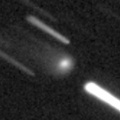
|
Now it is 14.8 mag (Aug. 18, Ken-ichi Kadota). It stays 14 mag for a while. It will be getting lower gradually after this, and it will be unobservable in October in the Southern Hemisphere, or in November in the Northern Hemisphere. But it will be observable again in December in the Northern Hemisphere. It is expected to brighten up to 12.5 mag in 2024 spring. At the high light, it will be observable in excellent condition in the Southern Hemisphere, but it will be low in the Northern Hemisphere.
Date(TT) R.A. (2000) Decl. Delta r Elong. m1 Best Time(A, h)
Aug. 26 15 14.04 7 15.6 3.530 3.382 73 14.7 20:04 ( 68, 39)
Sept. 2 15 11.13 5 36.4 3.608 3.340 66 14.7 19:53 ( 71, 34)
|
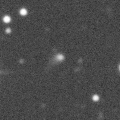
|
Now it is 15.6 mag (July 8, Thomas Lehmann). Brightening slowly. Now it is not observable. It will appear in September. It is expected to brighten up to 12 mag from 2024 to 2025.
Date(TT) R.A. (2000) Decl. Delta r Elong. m1 Best Time(A, h)
Aug. 26 9 24.19 3 28.3 5.942 4.972 14 14.8 3:58 (257,-13)
Sept. 2 9 27.16 3 37.4 5.874 4.933 19 14.7 4:05 (261, -6)
|

|
Now it is 14.3 mag (July 7, Thomas Lehmann). Fading slowly. In the Northern Hemisphere, it is not observable now. It locates somewhat low in the Southern Hemisphere. But it will become high in winter.
Date(TT) R.A. (2000) Decl. Delta r Elong. m1 Best Time(A, h)
Aug. 26 10 43.63 -47 58.3 2.826 2.463 58 14.7 20:04 ( 53,-41)
Sept. 2 11 8.71 -48 29.2 2.911 2.509 56 14.8 19:53 ( 52,-39)
|
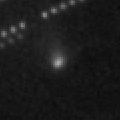
|
It brightened very rapidly. Now it is 15.2 mag (Aug. 3, ATLAS South Africa). It will fade out rapidly after this. It will be fainter than 18 mag in December. It will be unobservable in October in the Southern Hemisphere, or in November in the Northern Hemisphere. But it will be observable again in November in the Northern Hemisphere.
Date(TT) R.A. (2000) Decl. Delta r Elong. m1 Best Time(A, h)
Aug. 26 13 55.13 -30 5.7 2.227 2.045 66 14.8 20:04 ( 53, 0)
Sept. 2 13 58.07 -27 18.2 2.364 2.041 59 14.9 19:53 ( 57, -1)
|
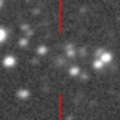
|
Now it is 14.6 mag (Aug. 5, J. L. Virlichie, P. Traverse, H. Roy, G. Houdin). Fading slowly. It locates somewhat low in the Northern Hemisphere. In the Southern Hemisphere, it stays observable in good condition.
Date(TT) R.A. (2000) Decl. Delta r Elong. m1 Best Time(A, h)
Aug. 26 17 55.26 -31 57.7 2.319 2.913 116 14.9 20:04 ( 6, 23)
Sept. 2 17 58.44 -32 30.1 2.406 2.916 110 15.0 19:53 ( 9, 22)
|

|
It approached to Earth down to 0.29 a.u. in early February, and it brightened up to 4.5 mag (Feb. 1, Juan Jose Gonzalez). Now it is 14.1 mag (Aug. 19, Thomas Lehmann). Fading slowly. In the Northern Hemisphere, it is not observable now, but it will appear in September. In the Southern Hemisphere, it stays observable in good condition.
Date(TT) R.A. (2000) Decl. Delta r Elong. m1 Best Time(A, h)
Aug. 26 6 37.85 -35 59.2 3.530 3.314 69 14.9 3:58 (312, -4)
Sept. 2 6 39.41 -38 19.9 3.544 3.390 73 15.1 4:05 (318, -1)
|

|
It will brighten up to 14 mag from 2024 to 2025. Now it is 15.2 mag (July 22, ATLAS Chile). It stays 15 mag for a while. In the Northern Hemisphere, it is not observable now, but it will appear in November. It locates somewhat low in the Southern Hemisphere. But it will become high in autumn.
Date(TT) R.A. (2000) Decl. Delta r Elong. m1 Best Time(A, h)
Aug. 26 10 19.67 -27 23.5 6.523 5.761 38 15.2 20:04 ( 81,-39)
Sept. 2 10 26.69 -27 40.7 6.520 5.735 36 15.2 4:05 (282,-35)
|

|
It has not been observed yet in this apparition. It was expected to brighten rapidly up to 15 mag in summer. But actually, it is not detected, fainter than 19 mag (Aug. 12, Martin Masek). It stays 16 mag for a while. It locates somewhat low in the Northern Hemisphere. In the Southern Hemisphere, it stays observable in good condition.
Date(TT) R.A. (2000) Decl. Delta r Elong. m1 Best Time(A, h)
Aug. 26 17 3.78 -28 49.3 1.557 2.069 105 15.3 20:04 ( 18, 24)
Sept. 2 17 12.75 -28 10.5 1.614 2.054 100 15.3 19:53 ( 20, 24)
|

|
Now it is 15.7 mag (Aug. 1, ATLAS Chile). Fading gradually. It locates somewhat low in the Northern Hemisphere. In the Southern Hemisphere, it will be getting lower gradually after this, and it will be unobservable in December.
Date(TT) R.A. (2000) Decl. Delta r Elong. m1 Best Time(A, h)
Aug. 26 17 8.49 -20 33.0 2.285 2.738 105 15.5 20:04 ( 20, 32)
Sept. 2 17 13.94 -20 49.5 2.415 2.778 100 15.7 19:53 ( 23, 31)
|
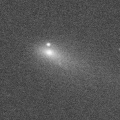
|
It brightened up to 12.8 mag in spring (Mar. 8, Taras Prystavski). Now it is 15.9 mag (Aug. 18, Ken-ichi Kadota). It will fade out rapidly after this. It will be fainter than 18 mag in November. It stays observable in good condition.
Date(TT) R.A. (2000) Decl. Delta r Elong. m1 Best Time(A, h)
Aug. 26 1 32.85 -2 55.5 1.663 2.446 130 15.5 3:19 ( 0, 52)
Sept. 2 1 29.69 -3 21.8 1.640 2.484 138 15.6 2:48 ( 0, 52)
|

|
Now it is 15.6 mag (Aug. 11, ATLAS South Africa). Fading slowly. It stays observable in good condition.
Date(TT) R.A. (2000) Decl. Delta r Elong. m1 Best Time(A, h)
Aug. 26 0 45.37 -5 57.9 2.742 3.600 142 15.8 2:31 ( 0, 49)
Sept. 2 0 42.39 -6 21.9 2.705 3.616 150 15.8 2:01 ( 0, 49)
|

|
It will approach to Sun down to 0.4 a.u. in late September in 2024, and it is expected to brighten up to 0 mag. Now it is 15.9 mag (Aug. 13, ATLAS South Africa). Brightening slowly. It will be unobservable in October. But it will be observable again in November in the Northern Hemisphere, or in December in the Southern Hemisphere. At the high light, in the Northern Hemisphere, it will be observable in good condition after the perihelion passage. In the Southern Hemisphere, it will be observable in the low sky before and after the perihelion passage.
Date(TT) R.A. (2000) Decl. Delta r Elong. m1 Best Time(A, h)
Aug. 26 14 4.16 0 34.7 6.077 5.597 57 15.9 20:04 ( 75, 21)
Sept. 2 14 5.40 0 7.3 6.103 5.527 51 15.9 19:53 ( 77, 18)
|
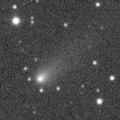
|
Now it is 15.9 mag (Aug. 2, ATLAS South Africa). Fading gradually. It will be fainter than 18 mag in November. It stays extremely low in the Northern Hemisphere. In the Southern Hemisphere, it will be getting lower gradually.
Date(TT) R.A. (2000) Decl. Delta r Elong. m1 Best Time(A, h)
Aug. 26 14 35.61 -37 9.3 2.557 2.532 77 16.1 20:04 ( 41, 1)
Sept. 2 14 47.84 -37 45.0 2.648 2.549 73 16.3 19:53 ( 42, 0)
|

|
It is expected to brighten up to 14 mag in winter. Now it is 17.8 mag (Aug. 3, Ken-ichi Kadota). Brightening gradually. It stays observable in good condition.
Date(TT) R.A. (2000) Decl. Delta r Elong. m1 Best Time(A, h)
Aug. 26 3 17.91 13 19.3 2.473 2.853 101 16.4 3:58 (322, 64)
Sept. 2 3 22.64 13 43.9 2.349 2.816 107 16.3 4:05 (337, 67)
|
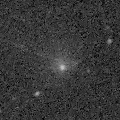
|
Very large comet. It is expected to brighten up to 13 mag in 2031. Now it is 15.7 mag (Aug. 19, Thomas Lehmann). It stays 16 mag for a while. In the Northern Hemisphere, it is not observable now. In the Southern Hemisphere, it stays observable in good condition. In the Northern Hemisphere, it is not observable until 2030.
Date(TT) R.A. (2000) Decl. Delta r Elong. m1 Best Time(A, h)
Aug. 26 3 33.75 -62 8.2 17.022 17.302 104 16.3 3:58 (351, -8)
Sept. 2 3 33.85 -62 36.4 16.986 17.277 105 16.3 4:05 (355, -8)
|
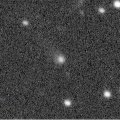
|
Now it is 16.5 mag (Apr. 10, Michael Jager). It stays 16 mag for a while. In the Northern Hemisphere, it is not observable now, but it will appear in October. In the Southern Hemisphere, it will be getting higher gradually.
Date(TT) R.A. (2000) Decl. Delta r Elong. m1 Best Time(A, h)
Aug. 26 9 8.68 -24 10.6 4.451 3.716 38 16.4 3:58 (283,-25)
Sept. 2 9 13.24 -25 55.1 4.422 3.711 40 16.4 4:05 (289,-20)
|
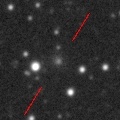
|
Now it is 16.7 mag (Aug. 3, Ken-ichi Kadota). It stays 17 mag for a while. In the Northern Hemisphere, it stays observable in good condition. In the Southern Hemisphere, it will be getting lower gradually after this, and it will be unobservable in December.
Date(TT) R.A. (2000) Decl. Delta r Elong. m1 Best Time(A, h)
Aug. 26 17 44.51 -11 0.8 2.035 2.606 113 16.6 20:04 ( 12, 43)
Sept. 2 17 47.68 -11 15.0 2.098 2.588 107 16.6 19:53 ( 17, 42)
|
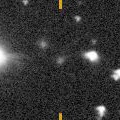
|
It is expected to brighten up to 14 mag in 2024 summer. At the high light, it is not observable in the Northern Hemisphere. Now it is 17.4 mag (Aug. 17, Ken-ichi Kadota). Brightening slowly. It stays observable in good condition.
Date(TT) R.A. (2000) Decl. Delta r Elong. m1 Best Time(A, h)
Aug. 26 3 31.86 1 47.1 3.950 4.255 100 16.8 3:58 (326, 52)
Sept. 2 3 31.70 0 12.9 3.792 4.206 107 16.6 4:05 (341, 54)
|

|
It returns for the first time in 68 years. It will brighten up to 7.5 mag in 2024 summer. It has not been observed yet in this apparition. It will brighten rapidly after this. It stays observable in good condition. At the high light, it locates low in the Northern Hemisphere, or it is not observable in the Southern Hemisphere.
Date(TT) R.A. (2000) Decl. Delta r Elong. m1 Best Time(A, h)
Aug. 26 4 20.99 -15 2.8 3.836 3.996 91 16.9 3:58 (323, 31)
Sept. 2 4 23.85 -15 32.3 3.685 3.930 96 16.7 4:05 (331, 35)
|

|
Very far object. Now it is 17.3 mag (July 23, ATLAS South Africa). It stays 17 mag for a while. In the Northern Hemisphere, it is not observable now. In the Southern Hemisphere, it stays observable in good condition.
Date(TT) R.A. (2000) Decl. Delta r Elong. m1 Best Time(A, h)
Aug. 26 5 49.16 -71 5.1 10.222 10.322 92 16.8 3:58 (343,-23)
Sept. 2 5 48.53 -71 45.4 10.224 10.321 92 16.8 4:05 (346,-21)
|

|
It brightened up to 14.1 mag in 2022 spring (Mar. 22, 2022, Chris Wyatt). It was expected to brighten up to 13 mag. But actually, it was fainter than originally expected. Now it is 16.5 mag (Aug. 17, Thomas Lehmann). It stays 17 mag for a while. It stays observable in good condition.
Date(TT) R.A. (2000) Decl. Delta r Elong. m1 Best Time(A, h)
Aug. 26 2 57.93 -2 34.0 4.645 5.078 109 16.9 3:58 (342, 51)
Sept. 2 2 54.02 -2 33.6 4.585 5.124 117 16.9 4:05 (357, 52)
|

|
It brightened up to 13.4 mag in last summer (July 7, 2022, Giuseppe Pappa). Now it is 16.6 mag (Aug. 5, Hirohisa Sato). It stays 17 mag for a while. In the Northern Hemisphere, it will be getting lower gradually. But it will be getting higher again after November. In the Southern Hemisphere, it will be unobservable in October.
Date(TT) R.A. (2000) Decl. Delta r Elong. m1 Best Time(A, h)
Aug. 26 15 19.34 31 25.4 4.630 4.428 72 16.9 20:04 ( 98, 52)
Sept. 2 15 19.50 30 57.8 4.752 4.475 68 17.0 19:53 ( 99, 49)
|
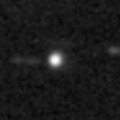
|
Now it is 16.4 mag (Aug. 10, Ken-ichi Kadota). Fading gradually. It will be fainter than 18 mag in October. It stays observable in good condition. It was very faint as 21.5 mag in 2021. It seems to be bright temporarily in outburst.
Date(TT) R.A. (2000) Decl. Delta r Elong. m1 Best Time(A, h)
Aug. 26 21 18.83 -11 16.2 3.507 4.494 165 16.9 23:01 ( 0, 44)
Sept. 2 21 15.41 -11 27.6 3.554 4.507 158 17.1 22:30 ( 0, 44)
|
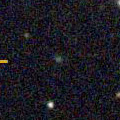
|
Now it is 17.7 mag (Aug. 3, ATLAS-HKO, Haleakala). It stays 17 mag for a while. In the Northern Hemisphere, it stays observable in good condition. It stays extremely low in the Southern Hemisphere.
Date(TT) R.A. (2000) Decl. Delta r Elong. m1 Best Time(A, h)
Aug. 26 4 49.74 37 40.8 6.898 6.743 76 17.1 3:58 (253, 58)
Sept. 2 4 53.10 38 4.7 6.788 6.737 82 17.1 4:05 (254, 64)
|
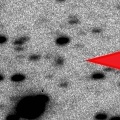
|
Now it is 16.9 mag (Aug. 6, Jean-Claude Merlin). It stays 17 mag for a while. It will be unobservable in October in the Northern Hemisphere, or in November in the Southern Hemisphere. But it will be observable again in December in the Southern Hemisphere. It stays 16 mag in the Southern sky for a long time from 2024 to 2025.
Date(TT) R.A. (2000) Decl. Delta r Elong. m1 Best Time(A, h)
Aug. 26 16 32.07 -40 16.1 6.245 6.494 99 17.1 20:04 ( 21, 11)
Sept. 2 16 28.87 -40 4.8 6.337 6.464 92 17.1 19:53 ( 24, 9)
|

|
Now it is 17.3 mag (Aug. 5, ATLAS South Africa). It stays 17 mag for a while. It stays observable in good condition.
Date(TT) R.A. (2000) Decl. Delta r Elong. m1 Best Time(A, h)
Aug. 26 4 53.01 -9 42.1 7.690 7.634 83 17.3 3:58 (312, 31)
Sept. 2 4 55.03 -9 57.4 7.564 7.601 88 17.2 4:05 (320, 36)
|

|
It will brighten rapidly after this. It will be unobservable in October. But it will be observable again in November in the Southern Hemisphere.
Date(TT) R.A. (2000) Decl. Delta r Elong. m1 Best Time(A, h)
Aug. 26 7 24.02 24 48.6 1.787 1.258 43 17.5 3:58 (255, 23)
Sept. 2 7 49.63 23 11.1 1.650 1.159 43 17.2 4:05 (258, 24)
|

|
It has not been observed yet in this apparition. It tends to brighten after the perihelion passage. Fading gradually. It will be fainter than 18 mag in November. In the Northern Hemisphere, it will never be observable after this. In the Southern Hemisphere, it will be unobservable in October.
Date(TT) R.A. (2000) Decl. Delta r Elong. m1 Best Time(A, h)
Aug. 26 11 52.86 2 18.2 2.193 1.350 25 17.6 20:04 ( 96, -4)
Sept. 2 12 15.72 0 9.5 2.198 1.348 24 17.3 19:53 ( 93, -4)
|
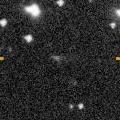
|
First return of a new periodic comet which brightened up to 15 mag in 2008. Now it is 17.4 mag (Aug. 3, Ken-ichi Kadota). Fading slowly. It will be fainter than 18 mag in November. It stays observable in good condition.
Date(TT) R.A. (2000) Decl. Delta r Elong. m1 Best Time(A, h)
Aug. 26 3 47.35 21 15.3 2.252 2.514 92 17.4 3:58 (297, 65)
Sept. 2 3 54.10 20 33.7 2.187 2.537 98 17.4 4:05 (310, 69)
|

|
Now it is 17.6 mag (Aug. 18, Ken-ichi Kadota). It stays 18 mag for a while. It stays observable in good condition.
Date(TT) R.A. (2000) Decl. Delta r Elong. m1 Best Time(A, h)
Aug. 26 3 45.57 8 52.6 2.731 3.008 95 17.6 3:58 (315, 56)
Sept. 2 3 50.23 8 40.9 2.650 3.017 101 17.6 4:05 (327, 60)
|

|
Now it is 17.6 mag (Aug. 7, Hirohisa Sato). It stays 18 mag for a while. In the Northern Hemisphere, it will be getting lower gradually. It stays extremely low in the Southern Hemisphere.
Date(TT) R.A. (2000) Decl. Delta r Elong. m1 Best Time(A, h)
Aug. 26 14 45.06 32 41.7 3.186 2.907 65 17.6 20:04 (103, 46)
Sept. 2 14 56.44 30 39.8 3.227 2.913 63 17.7 19:53 (101, 44)
|
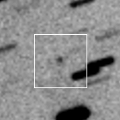
|
Now it is 18.2 mag (Aug. 18, ATLAS-HKO, Haleakala). It stays 17 mag for a while. In the Northern Hemisphere, it stays observable in good condition. In the Southern Hemisphere, it will be unobservable in November.
Date(TT) R.A. (2000) Decl. Delta r Elong. m1 Best Time(A, h)
Aug. 26 2 36.65 53 51.7 4.352 4.561 95 17.8 3:58 (191, 71)
Sept. 2 2 26.26 55 6.6 4.228 4.539 101 17.7 3:45 (180, 70)
|

|
It is expected to brighten up to 15 mag from autumn to winter. Now it is 18.7 mag (Aug. 11, Giuseppe Pappa). Brightening gradually. In the Northern Hemisphere, it is not observable now, but it will appear in October. In the Southern Hemisphere, it stays observable in good condition.
Date(TT) R.A. (2000) Decl. Delta r Elong. m1 Best Time(A, h)
Aug. 26 3 0.13 -56 33.5 1.535 2.100 109 18.0 3:58 (353, -2)
Sept. 2 3 0.06 -57 24.4 1.486 2.068 110 17.8 4:05 (358, -2)
|

|
Now it is 18.8 mag (Feb. 17, Toshihiko Ikemura, Hirohisa Sato). It stays 17 mag for a while. In the Northern Hemisphere, it stays observable in good condition. It stays extremely low in the Southern Hemisphere.
Date(TT) R.A. (2000) Decl. Delta r Elong. m1 Best Time(A, h)
Aug. 26 4 52.69 39 2.8 5.639 5.489 76 17.8 3:58 (251, 58)
Sept. 2 4 57.08 39 6.1 5.513 5.464 81 17.8 4:05 (251, 64)
|

|
Now it is 18.0 mag (July 28, Ken-ichi Kadota). Fading slowly. It will be fainter than 18 mag in October. It stays observable in good condition.
Date(TT) R.A. (2000) Decl. Delta r Elong. m1 Best Time(A, h)
Aug. 26 23 2.77 -14 56.1 2.050 3.045 168 17.8 0:49 ( 0, 40)
Sept. 2 22 59.02 -15 57.7 2.048 3.049 171 17.8 0:18 ( 0, 39)
|

|
It brightened up to 13.6 mag in 2021 (June 17, 2021, R. Carstens). Now it is 17.3 mag (June 9, D. Husar, M. Junius, S. Messner). It stays 18 mag for a while. In the Northern Hemisphere, it will never be observable after this. It locates somewhat low in the Southern Hemisphere.
Date(TT) R.A. (2000) Decl. Delta r Elong. m1 Best Time(A, h)
Aug. 26 11 15.69 -59 58.9 7.262 7.009 71 17.8 20:04 ( 37,-38)
Sept. 2 11 19.09 -59 57.8 7.350 7.044 68 17.9 19:53 ( 37,-39)
|
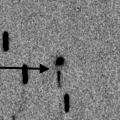
|
David Rankin detected its cometary activity in June. Now it is 16.4 mag (Aug. 17, Martin Masek). Fading slowly. It stays observable in good condition. It is brighter than this ephemeris recently.
Date(TT) R.A. (2000) Decl. Delta r Elong. m1 Best Time(A, h)
Aug. 26 22 22.10 -3 13.9 1.372 2.378 172 18.1 0:09 ( 0, 52)
Sept. 2 22 17.87 -3 22.3 1.347 2.350 172 18.0 23:32 ( 0, 52)
|
|
![]()
 126P/IRAS
126P/IRAS 237P/LINEAR
237P/LINEAR C/2022 W3 ( Leonard )
C/2022 W3 ( Leonard ) C/2021 X1 ( Maury-Attard )
C/2021 X1 ( Maury-Attard ) 29P/Schwassmann-Wachmann 1
29P/Schwassmann-Wachmann 1 C/2019 T4 ( ATLAS )
C/2019 T4 ( ATLAS ) C/2023 H2 ( Lemmon )
C/2023 H2 ( Lemmon ) 185P/Petriew
185P/Petriew C/2022 JK5 ( PanSTARRS )
C/2022 JK5 ( PanSTARRS ) C/2022 L2 ( ATLAS )
C/2022 L2 ( ATLAS ) C/2022 E2 ( ATLAS )
C/2022 E2 ( ATLAS ) C/2021 Y1 ( ATLAS )
C/2021 Y1 ( ATLAS ) C/2023 K1 ( ATLAS )
C/2023 K1 ( ATLAS ) 199P/Shoemaker 4
199P/Shoemaker 4 C/2022 E3 ( ZTF )
C/2022 E3 ( ZTF ) C/2021 G2 ( ATLAS )
C/2021 G2 ( ATLAS ) 213P/Van Ness
213P/Van Ness 81P/Wild 2
81P/Wild 2 71P/Clark
71P/Clark 117P/Helin-Roman-Alu 1
117P/Helin-Roman-Alu 1 C/2023 A3 ( Tsuchinshan-ATLAS )
C/2023 A3 ( Tsuchinshan-ATLAS ) 77P/Longmore
77P/Longmore 32P/Comas Sola
32P/Comas Sola C/2014 UN271 ( Bernardinelli-Bernstein )
C/2014 UN271 ( Bernardinelli-Bernstein ) C/2022 A3 ( Lemmon-ATLAS )
C/2022 A3 ( Lemmon-ATLAS ) 219P/LINEAR
219P/LINEAR C/2022 S4 ( Lemmon )
C/2022 S4 ( Lemmon ) 13P/Olbers
13P/Olbers C/2019 E3 ( ATLAS )
C/2019 E3 ( ATLAS ) C/2020 Y2 ( ATLAS )
C/2020 Y2 ( ATLAS ) C/2020 R7 ( ATLAS )
C/2020 R7 ( ATLAS ) P/2023 M4 ( ATLAS )
P/2023 M4 ( ATLAS ) C/2021 S4 ( Tsuchinshan )
C/2021 S4 ( Tsuchinshan ) C/2023 F3 ( ATLAS )
C/2023 F3 ( ATLAS ) C/2022 QE78 ( ATLAS )
C/2022 QE78 ( ATLAS ) (3200) Phaethon
(3200) Phaethon 339P/Gibbs
339P/Gibbs 465P/2023 L1 ( Hill )
465P/2023 L1 ( Hill ) 170P/Christensen
170P/Christensen C/2022 U4 ( Bok )
C/2022 U4 ( Bok ) C/2022 U1 ( Leonard )
C/2022 U1 ( Leonard ) 226P/Pigott-LINEAR-Kowalski
226P/Pigott-LINEAR-Kowalski C/2022 U3 ( Bok )
C/2022 U3 ( Bok ) 287P/Christensen
287P/Christensen C/2018 U1 ( Lemmon )
C/2018 U1 ( Lemmon ) 2023 KF3
2023 KF3![]()






















































